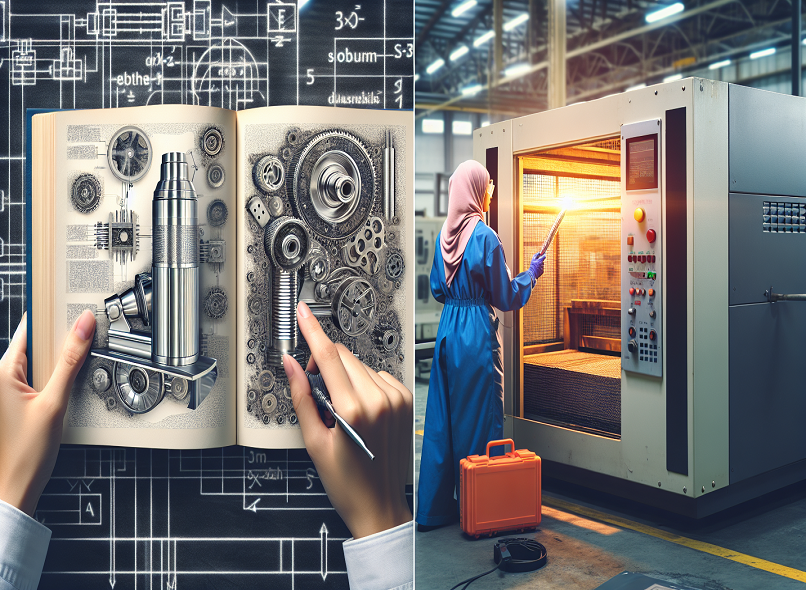From Theory to Practice: Practical Applications of Ultrasonic Machines in Industry

Ultrasonic technology has revolutionized various industries, offering a cleaner, environmentally friendly alternative to traditional solvent degreasing in precision cleaning applications. This shift highlights the broadening scope of ultrasonic applications, underscoring their significance in modern industrial processes. By leveraging ultrasonic machines, industries are not only enhancing efficiency but also committing to sustainable practices.
This article delves into the practical applications of ultrasonic machines across different sectors, detailing how this technology fosters innovation and addresses contemporary challenges. From the fundamental principles behind ultrasonic technology to the latest advancements and future outlook, each section provides a comprehensive view of how ultrasonic applications drive progress in industrial practices.
The Fundamentals of Ultrasonic Technology
Ultrasonic technology utilizes high-frequency sound waves to perform various tasks in industrial settings. At the core of this technology are ultrasonic transducers, which convert electrical energy into mechanical vibrations. These transducers come in two main types: magnetostrictive and piezoelectric.
Ultrasonic Cleaning Process
-
Mechanism: Ultrasonic cleaning harnesses ultrasound waves to generate cavitation bubbles in a liquid medium. These bubbles implode on the surface, effectively dislodging contaminants from objects submerged in the cleaning solution .
-
Frequency and Intensity: The operation frequency varies based on the application:
-
25 kHz for rough cleaning
-
40 kHz for moderate contamination
-
80 kHz for delicate parts
-
Over 100 kHz for specialized applications The intensity of the ultrasound typically ranges from 8-10 W/l in large tanks to 15-25 W/l in smaller tanks, adjusting for quick effects and high efficiency .
-
Ultrasonic Sensing and Testing
-
Ultrasonic Sensors: These devices emit ultrasonic waves that reflect off surfaces to measure the distance and presence of objects. They are advantageous in various environments as they are unaffected by color, transparency, and ambient light conditions .
-
Ultrasonic Testing (UT): This non-destructive testing method uses high-frequency sound waves to detect flaws in materials and components. It includes techniques for flaw detection, dimensional measurements, and material characterization. UT systems comprise pulser/receivers, transducers, and display units .
-
Advantages and Limitations: UT is highly sensitive to both surface and subsurface discontinuities and offers deep penetration for flaw detection. However, it requires direct access to the test surface and skilled operation, and certain materials and defects may pose challenges .
Ultrasonic Measurement Techniques
-
Thickness Measurement: Ultrasonic thickness measurement operates on the principle that distance equals velocity times time. This method is critical in settings where material integrity and thickness are concerns .
-
Calibration and Probe Selection: Effective ultrasonic testing requires proper calibration using suitable samples and the selection of appropriate probes. Calibration ensures the accuracy and reliability of measurements .
Advanced Ultrasonic Applications
Ultrasonic technology also extends to machining, particularly in processing hard and brittle materials like glass and ceramics. Ultrasonic machining, or ultrasonic vibration machining, involves high-frequency vibrations that facilitate the removal of material without the need for thermal processes.
These fundamental aspects of ultrasonic technology illustrate its versatility and capability in enhancing industrial processes through advanced cleaning, precise testing, and innovative machining techniques.
Applications of Ultrasonic Machines in Industries
Ultrasonic technology plays a pivotal role in various industrial applications, demonstrating its versatility and efficiency across multiple sectors. Here, we explore the diverse uses of ultrasonic machines in industries, highlighting their impact on enhancing operational processes and product quality.
Ultrasonic Cleaning Applications
Ultrasonic cleaning machines are integral to industries such as automotive, medical, and remanufacturing. These machines excel in removing tough contaminants like oils, lubricants, and rust, particularly in the automotive sector 1. In medical settings, they ensure the high standard of cleanliness required for tools and equipment, while in the remanufacturing sector, they effectively clean parts prior to repair or refurbishment. The benefits of ultrasonic cleaning include shorter process times, lower costs, and high-quality results, making it a preferred method for maintaining stringent cleanliness standards.
Industrial Ultrasonic Testing
Ultrasonic testing (UT) is utilized across various sectors, including aerospace, automotive, and oil and gas, for quality control and preventive maintenance. This non-destructive testing method helps in detecting early signs of equipment failure and refining measurement accuracy, thereby enhancing overall safety and efficiency in industrial operations.
Ultrasonic Machining and Welding
Ultrasonic Machining (USM) and Ultrasonic Welding are advanced processes used in industries such as aerospace, automotive, and electronics. USM involves high-frequency mechanical vibrations to remove material from workpieces, using abrasive slurry for effective material removal. Ultrasonic welding, on the other hand, is crucial for joining materials in manufacturing processes, offering a fast, energy-efficient, and high-quality method of assembly.
Ultrasonic in Material and Chemical Processing
High power ultrasonics find extensive applications in metal forming, treatment of molten metals, and chemical processing. Ultrasonic Peening (UP) is another innovative application where high-frequency impacts and oscillations treat materials and welded elements, enhancing their durability and performance.
Ultrasonic Applications in Biotechnology and Food Industries
Ultrasonic cavitation techniques are employed in biotechnology for the extraction of bioactive compounds and in fermentation processes. In the food and beverage industry, these techniques assist in emulsification and crystallization, improving product quality and efficiency.
Ultrasonic Technology in Environmental Applications
Innovatively, ultrasonic machines are also used in water and wastewater treatment, showcasing their environmental applications. This technology aids in enhancing oil recovery and desulfurization in the petroleum industry, and in textile processing, it is used for dyeing and finishing, demonstrating its ecological and sustainable benefits.
Through these applications, ultrasonic machines significantly contribute to the advancement of industrial processes, offering solutions that are not only effective but also environmentally friendly and cost-efficient.
Advancements in Ultrasonic Machine Technology
Matrix technology in ultrasonic inspections represents a significant leap forward, offering more flexibility and requiring less mechanical effort than traditional phased array systems. This advancement reduces human error and enhances overall functionality, making it particularly useful in industries where precision is critical.
Continued developments are focusing on improving the spatial resolution of matrix array probes. These enhancements allow for more detailed and accurate imaging during material inspections, crucial for industries that rely on high standards of safety and quality.
The integration of automation and electronics into ultrasonic testing (UT) tasks is transforming the inspection landscape. This integration simplifies complex inspection processes, particularly in challenging environments or when dealing with components that have complex geometries.
Portable ultrasonic technology, including phased and matrix array systems, has become indispensable for manual inspections in confined or rugged conditions. These systems provide not only efficiency and portability but also greater accessibility, making them ideal for industries such as aerospace, space exploration, and wind energy.
The Krautkrämer USM 100 Pro by Waygate Technologies is notable as the first portable conventional flaw detector capable of performing B/C scans. This capability allows operators to visualize a larger amount of data and identify multiple defects in a single image, enhancing the effectiveness of inspections.
Fuji Electric's FSZ S-Flow is an innovative ultrasonic flowmeter designed for measuring the flow rate of liquids in small pipes. It utilizes the transit-time measuring method and features an LED display for easy result reading, suitable for various industrial applications.
The Ultraprobe 15,000 from UE Systems exemplifies the advancement in condition monitoring systems. It analyzes plant equipment for potential issues such as degradation, leaks, and lubrication needs, thereby facilitating comprehensive condition inspection and data collection.
LubeMatrix by IndustrialMatrix represents a breakthrough in autonomous condition-based monitoring and lubrication solutions. It uses ultrasound sensors to measure decibel levels in real time and dispenses lubricant accordingly through an automated system, optimizing maintenance procedures.
MassaSonic Gizmo from Massa Products Corp is a wireless level measurement sensor that connects via Wi-Fi and cellular networks. It is also being developed to support long-range (LoRa) radio communication, enhancing its utility in remote monitoring applications.
The Model 9207 Ultrasonic Leak Detector (ULD) from EXAIR can detect leaks from up to 20 feet away. It converts ultrasonic signatures to audible frequencies and uses LED lighting to confirm the location of a leak, proving essential for maintaining operational integrity in various settings.
The Ransohoff RBS Modular System from Cleaning Technologies Group utilizes ultrasonic technology for high-volume parts washing. Its capability to handle immersed, challenging parts makes it a valuable addition to industrial cleaning processes.
Ultrasonic motors are gaining traction for their precise and controlled motion capabilities, ideal for applications in robotics, medical equipment, aerospace and defense, consumer electronics, and semiconductor manufacturing. These motors are crucial for driving innovation in these technologically advanced fields.
In the realm of non-destructive testing (NDT), phased array ultrasound technology is addressing common challenges by offering enhanced capabilities such as linear scanning and the ability to scan from multiple angles. This technology is particularly advantageous for industries requiring thorough inspections and quality assurance.
Ultrasonic sensors continue to be a low-cost yet effective solution for object detection, capable of operating under challenging conditions such as dust, smoke, or fog. Their versatility extends across various applications, underscoring their importance in modern industrial setups.
The ultrasonic cleaning market is projected to grow significantly, reaching an estimated US $3.2 billion by 2033. This growth is driven by the increasing demand for environmentally friendly and efficient cleaning solutions, coupled with continuous technological advancements in the field.
As ultrasonic technology continues to evolve, its applications are expanding into precision cleaning of micro and nanoscale components, as well as the cleaning of soft and delicate materials. These advancements are opening new possibilities in the automotive and aerospace industries, where emerging technologies demand innovative cleaning solutions.
Continuous technological advancements are essential to improve the reliability and practicality of ultrasonic technology, especially with the introduction of new materials and components in various industries.
Research and development efforts are increasingly focusing on electronics and software-based automation in ultrasonic testing solutions. These efforts aim to reduce manual control, enhance automation, and provide more compact, multi-dimensional technology for better defect detection and reduced human error.
Challenges and Solutions in Ultrasonic Technology Implementation
Challenges in Ultrasonic Nondestructive Testing (NDT)
Conventional Ultrasonic Sensors Limitations
Conventional ultrasonic sensors often face challenges such as limited testing distance and inflexible scanning methods, which can lead to inaccurate readings. These sensors are typically restricted by the confined reach of standard scanners and ultrasonic arm scanners, limited by the capacity of the X-Y interface. Additionally, long-range ultrasonic testing (LRUT) struggles with accurately determining corrosion locations and differentiating between active and passive corrosion, which can impede effective maintenance strategies.
Factors Affecting Accuracy
The accuracy of ultrasonic NDT can be compromised by various factors including odd formations, accessibility issues, and material composition. Conventional probes may not be flexible enough to handle high-grain materials, leading to incorrect data. Moreover, these standard probes might overlook small or linear flaws that run parallel to the beam itself, posing significant risks in critical applications.
Ultrasonic Flow Metering Challenges
Impact of Fluid Dynamics
The accuracy of ultrasonic flow meters can be significantly affected by the distribution of fluid velocity across the pipe. Distorted flow profiles, which may result from bends, valves, or changes in diameter, pose substantial challenges.
Environmental and Material Factors
Characteristics such as density, viscosity, temperature, pressure, and composition of the fluid can influence the performance of ultrasonic flow meters. Changes in these properties may necessitate recalibration and can impact the meter's accuracy.
Installation and Calibration Issues
Precise installation of transducers is crucial for accurate readings. Challenges in this area include variations in pipe material, wall thickness, surface condition, coupling, and the angle of installation. Adhering to manufacturer's guidelines and regular maintenance are essential for ensuring reliability.
Solutions to Ultrasonic Technology Challenges
Enhancing Sensor Technology
To overcome the limitations of conventional ultrasonic sensors, advancements such as phased array ultrasonic testing (PAUT) offer more comprehensive scanning mechanisms. These technologies allow for greater flexibility and accuracy in NDT applications.
Optimizing Flow Meter Installation
For ultrasonic flow metering, installing the meter in a location where the flow profile is stable is crucial. Following manufacturer’s guidelines for minimum pipe lengths before and after the meter can also help in achieving more accurate measurements.
Advanced Signal Processing
Incorporating advanced signal processing features like digital processing, filtering, and calibration can mitigate issues related to noise, interference, and measurement errors in ultrasonic applications. Selecting a meter that fits the specific needs of the application, such as flow range, accuracy, and response time, is also vital for overcoming challenges.
By addressing these challenges with informed solutions and technological advancements, the implementation of ultrasonic technology in industrial applications can continue to grow in effectiveness and reliability.
The Future of Ultrasonic Machines in Industry
Ultrasonic technology continues to play a critical role in enhancing industrial safety and efficiency. The railway industry, for example, relies heavily on ultrasonic testing to ensure the safety and reliability of railway wheels. State-of-the-art inspection machines now allow comprehensive testing without the need to remove the wheelset from the rail car, streamlining maintenance processes and reducing downtime.
In various industries, ultrasonic sensors are employed for diverse applications such as tank level monitoring, production line sensors, and distance measurement. These sensors offer significant advantages by being independent of the target's size, material, or reflectivity and provide continuous distance calculations, which is crucial for maintaining operational efficiency.
Precision Fabricating & Cleaning (PFC) leverages ultrasonic waves to provide tailor-made cleaning solutions across multiple industries. Their units are equipped with advanced features such as heaters, timers, sweep modes, rinsing, and drying units, which enhance the cleaning efficacy and adaptability to different industrial needs.
Industrial ultrasonic testing (UT) remains indispensable for ensuring the quality of critical composites, metals, alloys, and industrial assets with complex geometries. This form of testing is vital for industries that demand high precision and reliability in their operational processes.
Ultrasonic cavitation is another area seeing innovative applications. This technique is used to intensify various unit operations and processes, including disinfection, emulsification, and the degradation of organic pollutants. Its ability to improve these processes significantly contributes to more sustainable and efficient industrial practices.
Conclusion
Throughout this exploration of ultrasonic machines and their industry applications, we have observed a profound transformation empowered by high-frequency sound wave technology. The journey from basic principles to advanced implementations demonstrates the versatility and efficiency of ultrasonic technology in offering cleaner, sustainable, and innovative solutions across various sectors. By continually enhancing precision cleaning, material testing, and sophisticated machining, ultrasonic technology proves to be a cornerstone in the advancement of modern industrial practices, reflecting a commitment to environmental responsibility and operational excellence.
The broad implications of these advancements signal a promising future, where ultrasonic technology will play an even more significant role in addressing contemporary challenges and improving efficiency. As industries strive for greater sustainability and innovation, the continuous evolution of ultrasonic machines appears as a vital contributor to this goal. Therefore, further research and development in this field not only promise to refine existing applications but also to unlock new possibilities, reinforcing the technology's crucial position in propelling industries toward a more efficient and sustainable future.
FAQs
What are the various uses of ultrasonic waves in the industrial sector?
Ultrasonic waves are utilized in numerous industrial processes including cleaning, welding of both plastics and metals, cutting, forming, and material testing. Other applications involve separating, mixing, de-gassing, atomizing, localizing, measuring, and more.
How is ultrasonic energy practically applied in various settings?
Ultrasonic energy finds its practical application in high-intensity tasks. It is commonly used for cleaning items like jewelry, dentures, surgical instruments, and small machinery parts. Additionally, ultrasonic cleaning aids in degreasing processes. Moreover, large-scale ultrasonic cleaners have been developed to facilitate cleaning in assembly line environments.
What purposes do ultrasonic machines serve?
Ultrasonic machines, particularly rotary types, are engineered for machining advanced materials such as ceramics and alloys. These include glass, quartz, structural ceramics, titanium alloys, alumina, and silicon carbide. They are particularly effective for creating deep holes with high precision.
In what applications is ultrasound technology employed?
Ultrasound technology is employed across various fields including navigation, medicine, imaging, cleaning, mixing, communication, and testing, showcasing its versatility and broad utility.





